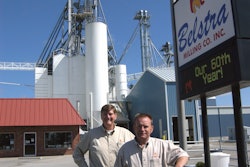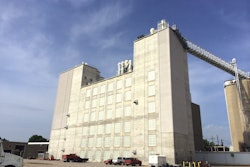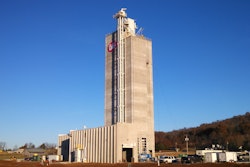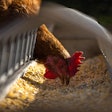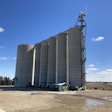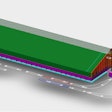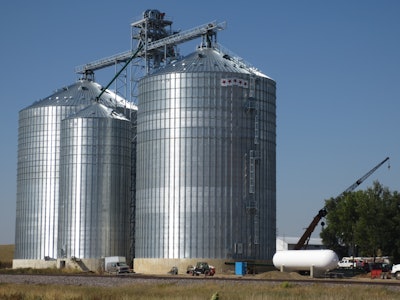
Two new 100-foot-tall steel bins, a state-of-the-art grain dryer and a shiny new 15,000-bushel/hour grain elevator leg stand high above where Five Star Co-op’s old wooden elevator once stood. The former 150,000-bushel soybean handling facility in Scarville, IA, was open and staffed only during harvest season and employees filled the nearly dozen small “government” bins using a grain auger.
Five Star Cooperative, a nearly 100-year-old cooperative with 1,900 members throughout northeast and north central Iowa, provides services and products in agronomy, grain, feed, petroleum and hardware.
Wayne Steven, Five Star Co-op’s operations manager, said the board voted to purchase the Scarville facility in 2005 with plans to eventually sell it to a producer. At that time, the facility was hardly valuable or efficient. Terrance Anderson, location manager since 1997, said he could unload only three to four truckloads/hour due to the size of the size and the outdated equipment on site.
“Everything was done manually and nothing happened quickly,” Anderson remembered. “It would take two weeks to fill up a bin and about a month to empty it. We used grain vacs to empty the bins, and it required a lot of manpower and effort. Both filling and emptying the soybean bins was a three- to four-man job.”
But despite the work flow shortcomings, Anderson saw potential in its location, knowing how badly the farmer-members needed a modern-day corn and soybean handling facility. With three ethanol facilities in a 20-mile radius of Scarville, corn producers wanted somewhere nearby to store their grain and be able to take it to market quickly. The Scarville location could, with a little work, provide that opportunity. After Anderson convinced the board not to sell the facility, Five Star’s leadership began discussing plans to expand and update the Scarville location to begin handling corn in addition to soybeans.
“We started talking about the expansion in 2008, but there were two other projects deemed more necessary at the time,” said Steven. Five Star Co-op completed its Hanlontown, IA, location first and in 2012 it focused on the Burchinal, IA, expansion because the board saw little demand in Scarville, which is situated just two miles south of the Minnesota-Iowa border. But the local producers had a different opinion.
“In February 2013, we talked [the board] into having a farmer meeting and that’s when everything changed,” said Steven. “They wanted speed and space.”
A turning point
In February 2013, Five Star Co-op held a farmer meeting at the town’s fire hall.
“能力30或40人,每个座位was full,” said Steven. “There was standing room only and all the feedback was positive. Board members and the general manager were dumbfounded.”
Steven said the overwhelming support sealed the deal for the co-op’s board, and he credits the community for making the expansion a reality.
“When we brought the farmers in and they all spoke positively about it, that was a big deal to the board,” Steven said. “We have a farmer meeting before any major expansion and we usually hear some negative feedback from one or two, but not this time.”
Five Star Co-op selected Lake Mills, IA-based Larson Contracting as the general contractor, and in March 2013, they began the grading and dirt work on the new facility. But this was not your typical expansion project.
A complete demolition was in order, including the scorching of its original wooden elevator.
Out with the old
Five Star Co-op worked with the local fire department to supervise the burn once it obtained the necessary permits from the Department of Natural Resources and made arrangements with the railroad company to stop all train traffic coming through the facility.
“On April 6 we burned the wood house down, and it only took 45 minutes,” said Steven. “We had every fire department in the county there, and they were a little disappointed that they didn’t get to practice long because it got so hot and burned so fast.”
In with the new
The construction crew continued to work rapidly for months, and the project was completed in time for the 2013 harvest. The new facility includes two dry grain bins: one 90 feet in diameter and one 78 feet in diameter, a 42-foot-diameter wet corn steel bin, a 4,700-bushel/hour grain dryer, a 15,000-bushel/hour dry grain elevator leg, an 8,500-bushel/hour wet grain elevator leg, a new receiving and load-out area and an overhead load-out tank, bringing total storage capacity to just over 1 million bushels.
In its maiden harvest, the facility took in a little more than 600,000 bushels of corn — the first time the Scarville location handled corn in 20 years, Anderson noted.
It marked the first time it ever accepted corn under Five Star Co-op’s ownership.
What impressed Anderson the most? “We didn’t have any lines at all,” he said. “We could empty about 10 to 15 truckloads/hour with our 15,000-bushel/hour leg, as opposed to three to four trucks/ hour last year. The producers were thrilled with the time in and out of the new elevator.”
史蒂文说,先进的干燥器not have been installed at a better time, considering that 2013 was the wettest northern Iowa had experienced in years. “We had 70% prevented planting because it was so wet this past year,” he said. “Through the end of May, this area received 30-some inches of rain for the spring. Usually [Scarville] gets that much rain all year!”
The dryer is rated at 4,700 bushels/hour, but due to the incoming corn’s moisture, Anderson said it performed at about 3,300 bushels/ hour. Anderson was pleased with the results of Brock’s Quantum Control, which monitors the moisture coming in to reach the desired moisture level on outgoing corn.
“We had it set at 15% moisture, and out of the 550,000 bushels we dried, the corn came out at 14.9%, which is fantastic because we received it at 19% to 30% moisture,” said Anderson.
In addition to a high-tech drying solution, Five Star invested in bin level monitors, temperature cables and moisture cables to monitor grain quality using more than just sight and visual cues.
“Before the expansion, during the off-season when there was no staff, I had to send a truck here for someone to monitor bins and all they could do is look in the top,” said Steven. “The difference is night and day from what it used to be to what it is today. Our bins now have temperature cables down through them and we monitor them once a week. The display is set up on the bottom, so you can look at them without having to enter the bin.”
Steven listed a few other advantages of having a workable, year-round facility. “If you came to work here in [December 2012], the toilet would be frozen and there would be three days of snowplowing to be done because nobody would have touched it all winter,” Steven said. Most notably, Five Star overcame its logistics struggles thanks to the location’s full-time status.
No more logistics logjam
The added storage capacity and year-round operations have allowed the co-op to grow its customer base while easing transportation troubles. Although the facility is located on a railroad track, Five Star does all of its receiving and shipping via truck.
Steven is responsible for routing at Five Star and said the former facility caused a logistics nightmare, requiring him to constantly haul soybeans out of Scarville to be stored at larger capacity locations.
“We’d have years where we’d get 230,000 to 240,000 bushels of beans, and we could only hold 150,000 bushels,” Steven said. “So, we’d haul in beans until we got close to full, and then I would route semis through here, pull the soybeans down and keep them going. Now, I don’t have to route trucks up here as quickly.”
Transloading the trucks with beans at the old facility was also difficult because “loading out of those tanks was not at all convenient,” Steven said. “Now the whole bean operation is much smoother.”
五星级现在可以关注其他方面的足总cility, like the proposed next expansion and the addition of a diesel fueling station kitty-corner from the grain elevator.
Expansion plans
The Scarville location was designed with enough room to add two 563,000-bushel bins for corn storage. This expansion is anticipated to begin in 2015.
The board has also approved plans to build a fueling station to accommodate the added members hauling grain to the site. In addition to wide access lanes, the station will have Cardtrol stations, a convenient, custom key/card account that allows approved customers to access fuel 24/7 and pay at time of transaction or bill to their co-op account. Five Star Credit Card holders will receive a discount on every fill-up.
“We put one up at our Hanlontown location in 2010 because there’s an ethanol plant across the street from it, and it’s worked really well for us” said Steven. “It’s already paid for itself.”
But to Anderson it makes more than just business sense. In the spirit of giving back to the farmers and community that gave him an entirely new workplace, he said, “We thought the fueling station would be nice for the community to have. It shows the farmers we’re here for the long haul; we’re setting up for their future as well as ours.”
| Equipment List | |
| Supplier | Equipment |
| Larson Contracting | Concrete work |
| Brock | 90-foot-diameter steel bin |
| Brock | 78-foot-diameter steel bin |
| Brock | 42-foot-diameter wet holding tank |
| Brock | Commercial tower dryer |
| Airlanco | Power roof exhausters |
| Tri-States Temperature Detection | Temperature cables |
| Single Pass | Sweep anchoring |
| Springland Commercial Bin Sweeps | Three 6000 Series bin sweeps |
| Hare Electric | Electrical work |
| Butler | Motor Control Center, erected by Larson Contracting |
| Elevator Services of Algona | Installing millwright contractor |
| Schlagel | 15,000-bushel/hour elevator leg (dry corn) |
| Schlagel | 16-foot five-hole distributor |
| Schlagel | 8,500-bushel/hour elevator leg (wet corn) |
| Tapco | Non-sparking belt splices |
| Dodge Motors | Elevator drives |
| Applied Power Products | Goodyear Supreme belting |
| LeMar | Galvanized 18 by18 foot tower with switchback stairway |
| LeMar | Series B truss catwalks |
| LeMar | Series A handrail truss |
| Meridian | Overhead load-out tank |






